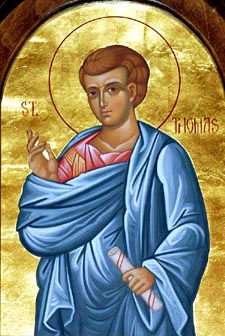Theology
Holy, Glorious Apostle Thomas
19. October 2017 - 9:06 The Holy and Glorious Apostle Thomas was born in the Galilean city of Pansada and was a fisherman. Hearing the good tidings of Jesus Christ, he left all and followed after Him. The Apostle Thomas is included in the number of the holy Twelve Apostles of the Savior.
The Holy and Glorious Apostle Thomas was born in the Galilean city of Pansada and was a fisherman. Hearing the good tidings of Jesus Christ, he left all and followed after Him. The Apostle Thomas is included in the number of the holy Twelve Apostles of the Savior.
According to Holy Scripture, the holy Apostle Thomas did not believe the reports of the other disciples about the Resurrection of Jesus Christ: “Unless I see in His hands the print of the nails, and put my finger into the print of the nails, and thrust my hand into His side, I will not believe” (John 20:25).
On the eighth day after the Resurrection, the Lord appeared to the Apostle Thomas and showed him His wounds. “My Lord and my God,” the Apostle cried out (John 20:28). “Thomas, being once weaker in faith than the other apostles,” says Saint John Chrysostom, “toiled through the grace of God more bravely, more zealously and tirelessly than them all, so that he went preaching over nearly all the earth, not fearing to proclaim the Word of God to savage nations.”
Venerable Cyriacus the Hermit of Palestine
12. October 2017 - 10:33 Saint Cyriacus was born at Corinth to the priest John and his wife Eudokia. Bishop Peter of Corinth, who was a relative, seeing that Cyriacus was growing up as a quiet and sensible child, made him a reader in church. Constant reading of the Holy Scriptures awakened in him a love for the Lord and of a yearning for a pure and saintly life.
Saint Cyriacus was born at Corinth to the priest John and his wife Eudokia. Bishop Peter of Corinth, who was a relative, seeing that Cyriacus was growing up as a quiet and sensible child, made him a reader in church. Constant reading of the Holy Scriptures awakened in him a love for the Lord and of a yearning for a pure and saintly life.
The Mystery of Theotokos in Byzantine Hymnography
10. October 2017 - 9:57Theotokology in Hymnography of St. John of Damascus
Bishop John (Puric), PhD
The name of the Virgin Mary is encountered not only in the Holy Scripture[1] and the Holy Tradition, but is mentioned in the entire life of the Orthodox Church: in divine worship, hymnography, iconography and music. Of special importance is the fact that the divine services of the Orthodox Church repeat the entire Theandric Economy of Salvation.[2]
Saint John the Theologian Preacher of Divine Love
9. October 2017 - 15:51 In the fall of 1962 or 1963, my husband and I arrived in Bad-Kissengen for a course of treatment at one of the sanatoriums. The following day I found my way to the Russian church, where I met the rector, Fr. Michael Zagoryansky. From the first moment of our acquaintance, this meek, amiable and kindly pastor became very dear to me. Our shared admiration for Vladika John (Maximovitch) undoubtedly contributed to this feeling of closeness.
In the fall of 1962 or 1963, my husband and I arrived in Bad-Kissengen for a course of treatment at one of the sanatoriums. The following day I found my way to the Russian church, where I met the rector, Fr. Michael Zagoryansky. From the first moment of our acquaintance, this meek, amiable and kindly pastor became very dear to me. Our shared admiration for Vladika John (Maximovitch) undoubtedly contributed to this feeling of closeness.
Why Are Vigil Lamps Lit Before Icons by St. Nikolai of Ohrid and Zica
18. September 2017 - 13:26Living Water
First - because our faith is light. Christ said: I am the light of the world (John 8,12). The light of the vigil lamp reminds us of that light by which Christ illumines our souls.
The Beheading of the Holy Glorious Prophet, Forerunner, and Baptist John
10. September 2017 - 17:46The Beheading of the Prophet, Forerunner of the Lord, John the Baptist: The Evangelists Matthew (Mt.14:1-12) and Mark (Mark 6:14-29) provide accounts about the martyric end of John the Baptist in the year 32 after the Birth of Christ.
 Following the Baptism of the Lord, Saint John the Baptist was locked up in prison by Herod Antipas, the Tetrarch (ruler of one fourth of the Holy Land) and governor of Galilee. (After the death of king Herod the Great, the Romans divided the territory of Palestine into four parts, and put a governor in charge of each part. Herod Antipas received Galilee from the emperor Augustus).
Following the Baptism of the Lord, Saint John the Baptist was locked up in prison by Herod Antipas, the Tetrarch (ruler of one fourth of the Holy Land) and governor of Galilee. (After the death of king Herod the Great, the Romans divided the territory of Palestine into four parts, and put a governor in charge of each part. Herod Antipas received Galilee from the emperor Augustus).
The prophet of God John openly denounced Herod for having left his lawful wife, the daughter of the Arabian king Aretas, and then instead cohabiting with Herodias, the wife of his brother Philip (Luke 3:19-20). On his birthday, Herod made a feast for dignitaries, the elders and a thousand chief citizens. Salome, the daughter of Herod, danced before the guests and charmed Herod. In gratitude to the girl, he swore to give her whatever she would ask, up to half his kingdom.

